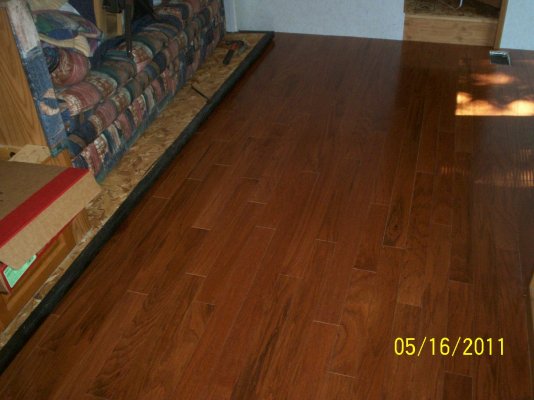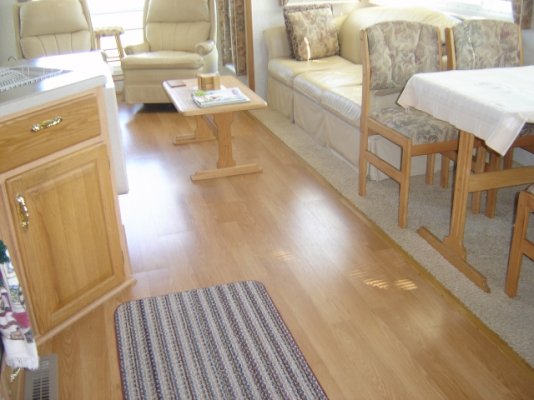I have searched every possible key word in this forum to try to figure out how I will protect this floor from the bottom of the slide floor.
I hear what you're saying. The trouble with slides is that you can't see the bottom of the slide unless you either remove the slide or part of the RV flooring and sub-flooring under the slide. Most of us have little idea of what the bottom of our slides look like or how it makes contact with the flooring as it moves in or out. If you have carpeting, you can see how the carpet gets matted as the slide rests on it while retracted, but that's about all. As far as I know, we don't even have the nomenclature defined to describe what's under there. Does the slide move on glides or gliders, runners, tracks, or what and how many different types are there in RVs?
[font=verdana, helvetica, sans-serif]In my case, I had to remove carpeting (and pad) and a section of sub-flooring that had rotted directly underneath the slide before adding vinyl laminate (TrafficMaster). Because of this, I was able to see the underside of our living room slide while the section of sub-flooring was removed. The bottom, inside-most edge of our slide, running the full length of the slide, has what I would call a white-colored plastic (or similar material) runner. It's about 3 inches wide and has beveled or somewhat rounded edges on the bottom of both the leading and trailing edges. It is oriented perpendicular to the movement of the slide and is the only thing resting on the MH floor when the slide is fully extended. The screws that hold the runner to the floor of the slide are countersunk. [/font]
[font=verdana, helvetica, sans-serif]After installing the vinyl laminate flooring, we worried that the slide runner would scratch the new flooring when the slide was extended or retracted. So we initially used a large sheet of cardboard placed under the runner to let the slide ride up on and travel on. After doing that several times, we noticed that the cardboard wasn't being compressed or damaged in any way by the runner and probably wasn't really needed, at least when the slide was being retracted. So after a time, we quit using the cardboard altogether. Now, almost a year later, we see some marks on the flooring where the slide moves in and out. We suspect that something like very small gravel got stuck between the runner and the flooring and ended up scratching it as it moved in or out. We don't know whether it occurred while extending the slide or retracting it. It's impossible to see anything under there so all we can do is try and keep the floor as clean as possible before retracting the slide.[/font]
[font=verdana, helvetica, sans-serif]So the bottom line is that we still don't know a lot about slides or how to keep them from marking up new flooring as they move in or out. RV manufacturers don't give us a lot of help in this regard either. They install carpeting which hides everything and expect that to remain in the RV forever. And when we decide we want a different kind of flooring, things get complicated rather quickly and we're left to sink or swim on our own.[/font]


